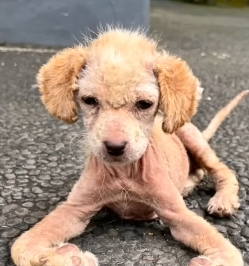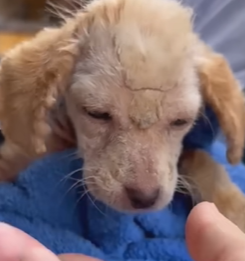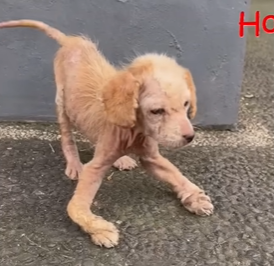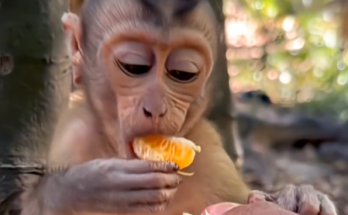
She stumbled through the dirt road, her fragile body trembling with every hesitant step. The sound of her paws scraping against gravel was the only thing that accompanied her — no warmth, no comfort, no kindness. Her legs, once strong and full of energy, were now deformed and twisted, the result of prolonged hunger and untreated pain. Her ribs pressed through her thin skin, her fur almost completely gone, eaten away by severe mange. Where soft golden hair once grew, there were now open wounds, scabs, and dry flakes of suffering.
For weeks, maybe months, she had been surviving on scraps — old rice, bits of plastic, and stagnant water. The villagers who saw her turned their heads away, wrinkling their noses in disgust. They didn’t see the fear and confusion in her eyes; they only saw something ugly and unwanted. Some threw stones. Others shouted, chasing her away as if she were a pest, not a living being that once knew love.
She used to have a family once — at least, she remembered shadows of one. A house, laughter, the smell of cooked food, and the gentle touch of a hand that used to pat her head. But when she fell sick and began losing her fur, when her body started to smell of infection, they grew tired of her. They opened the gate one day and pushed her out with a broom. She didn’t understand. She thought it was just a game — until the door closed and never opened again.
Now, every step hurt. Her hind legs twisted oddly, making it difficult to walk straight. She limped from one alley to another, searching for shelter. Her body was weak, but her spirit refused to surrender. In her eyes, there was still that small glimmer of life — fragile, but still there.

Days turned into nights, and nights into long, cold mornings. Rain soaked her skin, and the wind made her shiver uncontrollably. She curled herself beside a trash bin, where the smell of decay at least meant the chance of food. Every sound made her flinch — the honking of a motorbike, the shouting of people, the bark of healthy dogs. She didn’t belong anywhere anymore.
Then, one afternoon, her luck seemed to end. A group of teenagers saw her near the marketplace. They laughed when they noticed her twisted legs and missing fur. “Look at that monster!” one of them yelled. They threw rocks at her, and she tried to run, but her legs couldn’t move fast enough. She stumbled and fell, her body collapsing in the mud. They laughed harder, pointing, recording on their phones before walking away.
When they left, she tried to get up again. She whimpered softly, a cry for help that no one answered. She lay there for hours, her breathing shallow, her eyes half-closed. Maybe this was how it would end — alone, in pain, forgotten.
But fate, sometimes, has its own gentle surprises.
That evening, a woman passing by noticed her lying motionless near the trash bins. The woman slowed down, her heart twisting with sorrow. She saw not a monster, but a soul on the edge of life, one who had endured too much pain. Kneeling down, she whispered softly, “Hey, sweetheart… it’s okay. I see you.”

The dog’s eyes flickered open, filled with fear. She tried to crawl away, but her legs gave out again. The woman didn’t move closer — she just stayed there, talking in a calm, warm tone. Slowly, she placed a small piece of chicken on the ground. The smell made the dog’s stomach growl. Hunger was stronger than fear. She crawled closer, sniffed it, and began to eat, trembling.
That was the moment everything changed.
The woman called a local rescue group, and within an hour, volunteers arrived. They wrapped the dog in a soft blanket and lifted her carefully into their car. She whimpered softly, unsure of what was happening, but for the first time in a long while, she felt safe.
At the rescue center, the team worked tirelessly. They gave her a warm bath to clean off the crusted dirt and dead skin, treated her mange, and bandaged her wounds. She was named Hope, because even in her broken state, she still had that spark of will to live.
The vets examined her legs — the bones had twisted due to prolonged malnutrition, and some joints were partially fused. She might never walk perfectly again, but she could live without pain. It would take months of care, medicine, and physical therapy.
The first few days were tough. Hope refused to eat, too afraid of the hands that approached her. She flinched when someone moved too fast or raised their voice. But the rescue workers were patient. They sat beside her cage for hours, speaking softly, offering food, showing her that not all humans were cruel.

Weeks later, a transformation began. The mange started to heal. Tiny tufts of fur grew back, her skin slowly losing its raw redness. Her body still bore scars, but her eyes changed first — they brightened, reflecting the life returning within her. She began to wag her tail again, shyly at first, then with more confidence each day.
One of the volunteers, a young man named Leo, formed a special bond with her. He was the one who stayed late after everyone went home, gently massaging her twisted legs, helping her walk step by step. Hope trusted him. When he entered the room, she lifted her head and gave a weak bark — her way of saying thank you.
Months passed, and Hope began walking again, slowly but proudly. Her once-bare skin was now covered with soft white fur, her eyes clear and full of warmth. She had gained weight, her ribs no longer visible. Most importantly, she smiled — yes, dogs smile — especially when Leo was around.
The day finally came when Leo decided to take her home. He signed the adoption papers, tears welling in his eyes as he promised, “You’ll never be thrown away again.”

At his house, Hope had her own bed, toys, and bowls of food that never ran empty. She would sit by the window in the mornings, watching the sunlight dance on the floor, her tail thumping gently. Every now and then, she would limp toward Leo, rest her head on his lap, and close her eyes in peace.
She would never understand why she was abandoned, why people treated her like trash — but she didn’t need to. What mattered was now. She was loved, cherished, and safe.
Her story became known online after the rescue group shared her before-and-after pictures. Thousands of people were moved to tears by her transformation — from a broken, mangy dog that everyone drove away to a shining symbol of resilience and hope.
Hope taught the world something profound: that kindness can rewrite the story of even the most broken soul. That every living being, no matter how deformed or scarred, deserves a chance to heal and be loved.
And so, every time Leo watched her sleep, curled up peacefully, her twisted legs tucked beneath her soft fur, he whispered, “You’re perfect now, Hope. You always were.”
Because in the end, what was once driven away like trash became a treasure — proof that love can rescue even the most shattered heart.


